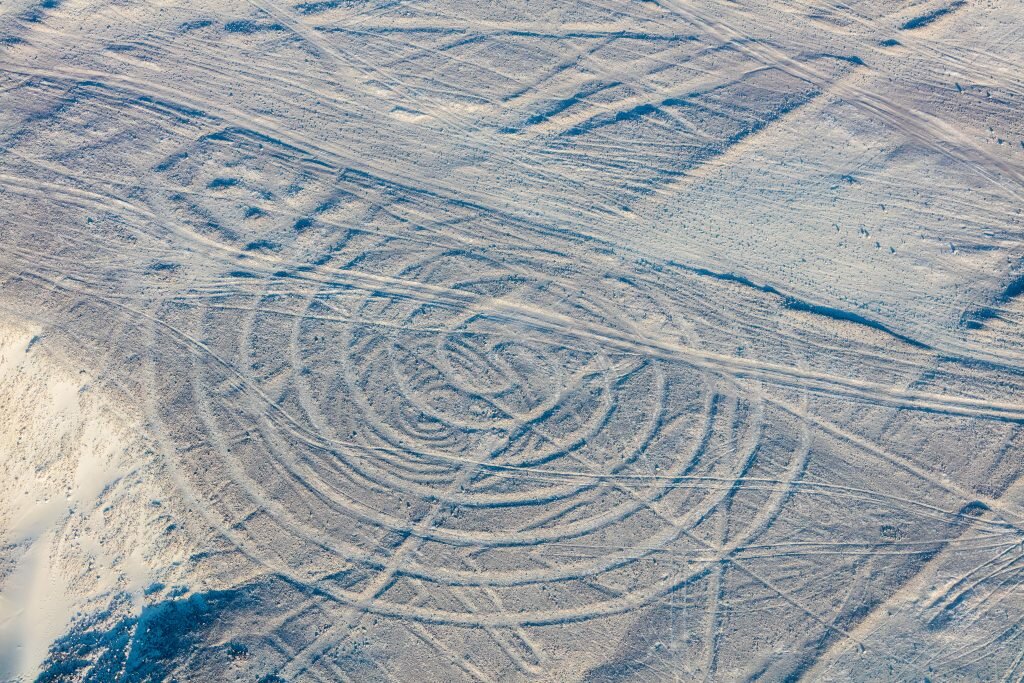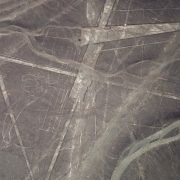Close encounters of all kinds

Excerpt from The Worlds I Love, a novel by Cuban author Daína Chaviano, translated by Yolanda Molina-Gavilán
It was the month of July and final examinations came along with it. During the breaks I turned myself to rest and clearing my mind as I went from one exam to the next. I distractedly picked up an old copy of América Latina magazine, and in it there was an article by Dr. Maria Reiche entitled “The Nazca Lines.”
I knew of the existence of those puzzling lines stretching along the Nazca desert in Peru. Dozens of birds, lizards, fish and other animals; trident-like objects; broken, parallel lines running in every direction; and geometric designs whose meaning escape us and date back to the era of the first American civilizations. They are one of archeology’s greatest mysteries. Yet, what was truly extraordinary about the lines was that they seemed to have been created by people who knew aviation or who were at least encouraged to draw them by people who knew how to fly, since such drawings can only be seen at a high altitude from the air. That’s why they were only discovered by our civilization during the second decade of the past century, when the airplane allowed man to fly over that Peruvian valley.
The article was meticulous, the measurements of the lines and the explanations of how they had been outlined were thorough as well. The what for and the why of their existence were, however, left unanswered. The possibility of an astronomical calendar was cautiously mentioned, but why would those primitive people —if they were so indeed— need a demanding, complicated calendar that would surely take them years of work and effort to complete? To top it off, it was a calendar they could never see or consult from the ground. Doesn’t it make more sense to believe that whoever thought of the lines did so for the purpose of taking a bigger, more direct advantage of them?
I reviewed one of the theories I had read on the subject, the one that in spite of being the simplest and most logical, is still the most controversial because of all the implications that its acceptance would bring. That theory states that whoever created the Nazca lines —or at least those who engineered them— were able to fly at great altitudes, the lines being a kind of sign or symbol for them to orient themselves from the air and thus be able to rectify their navigational course.
Personally, I don’t think that theory clashes with the idea of the astronomical calendar, although I think the latter could have served a secondary purpose, a result of the main one.
I mulled over the issue for two or three days. Both the weird “meteorite” and Reiche’s article plus a third issue I’ll mention next, made me do what —according to my parents, my siblings and two or three of the friends I told— was crazy: I wrote down or, I should say, drew some signs on the rooftop of my house. Needless to say, neither my friends nor my family knew the true reason or the facts that made me do that, and I didn’t tell them. In any case, that wouldn’t have much changed the opinion they already had about me.
Before describing what it was I drew and how I did it, I must recount —and I’ll be brief about it— the latest event that gave me the idea for the drawings.
One of my classmates, the only one with whom I could talk about the subject, confessed something to me that I’ve never questioned for various reasons: first of all, because I know him well and two of his traits happen to be seriousness and sincerity; and secondly, because he didn’t get anything out of telling me. On the contrary, it could have cost him my loss of trust, since this type of confessions generally causes intense hostility on the part of the listener. The fact that I haven’t decided to tell the truth until now is proof of that.
During one of our class breaks, the friend I’m telling you about took me aside to a corner to tell me that the day before, between 7:00 and 7:30 pm, as he walked by Havana Bay, he saw an oval shiny object crossing the sky above the sea parallel to the line of the horizon. Someone who was a few meters away also saw it, and even though, according to my friend, they didn’t know each other and had never met, they couldn’t help but exchange a few words of surprise.
I then started an obsession caused by such a complicated mental process that it would be impossible for me to put into words. The idea hounded me day and night, at all hours and in all places. I had to act. I knew they were there, at the reach of my hand; and yet, if I didn’t do something, I would lose my chance.
I knew —because I read articles in foreign newspapers— that those UFO incursions, or raids, existed. Whenever that happened, the UFOs would fly over a particular city or country for a while and then they’d vanish. The cause for those sudden appearances and disappearances is to me as unknown as it might be to any other one of the Earth’s inhabitants. And yet, I knew those sudden incursions happened, and I couldn’t remain indifferent about them.
The news that two UFOs had flown over the city in a two-week period (I was certain the “meteor” was a non-terrestrial vehicle) confirmed the idea that several dozens of them must have been doing that. Everything pointed to the fact that, if in a city of two million people and in such a short period of time one single person had had access to a phenomenon which was so rarely visible, then it followed that the event was happening by the dozens. I had to do something, but what? Then I saw the magazine on the Nazca lines. It gave me the answer.
At home they thought I was crazy. And in a way, I was. According to the norms that guided the average, ordinary person, anyone who had done what I did must necessarily be mad. I disregarded my siblings’ teasing and my parents’ scolding, and sketched the signs on our rooftop. The most difficult thing of all was finding a way to hit upon a message that would be intelligible to creatures from other worlds. And only in the case the UFOs were carrying people on board, since they could be unmanned, rather than manned spaceships.
If it was true they were visiting the Earth since times as remote as those of the Ancient Egyptian Empire (if we trust what’s written in the Tulli Papyrus, which is thirty-four centuries old,) I imagined they would be familiar with not just our socio-historical evolution, but also with basic human means of communication. The Morse code seemed to me to be the most appropriate one because of its graphic imagery based on dots and dashes. I chose two Morse signs. The first was the one normally used at the start of the transmission, a kind of warning meaning attention! Or we begin our broadcast! The second one is used to encourage a transmission, that is, when one awaits another person’s response. The message is clear and comprehensible if one knows the signs; therefore, this part doesn’t need further clarification.
Now I was missing something important.
I was inviting someone to communicate with me, but I wasn’t explaining who that someone was. I had to make clear that the contact must be made between a being from this planet and the inhabitants of another, something I finally did this way: I drew two huge circles that were somewhat distant from each other. Inside one of them I sketched the outline of the Americas and part of Europe and Asia, as they are depicted in any representation of the globe. Inside the other circle I drew an interrogation sign, which was meant to indicate that I didn’t know which planet I was going to contact. I assumed they must know that international sign if they are able to capture our TV signals and satellite transmissions.
Finally, I joined both circles with two arrows placed in opposite directions, which underscored the idea of communication between both worlds. I imagined that if they were able to decipher the interrogation sign, they would most likely understand the meaning of the arrows, an indisputably universal symbol. The drawing was white over a bright orange background.
To give an idea of the drawing’s size, I’ll say the terrace is about 26 by 10 meters long. The dots themselves were white circles of 35 centimeters in radius, and the circumference that represented the Earth was well over 3 meters long. It took me about six hours to finish and it looked more or less like this:
Daína Chaviano is a Cuban novelist and short story writer whose work has received international recognition and been translated into several languages. Chaviano is often referred to a top science fiction and fantasy writer in Spanish for her mastery of language and her original treatment of subject matter. This excerpt from Los mundos que amo [The Worlds I Love] was first published in 1980, and received the David Prize for Science Fiction in Cuba. Since 1991 she has lived in Miami, Florida. You can visit her webpage here.
Yolanda Molina-Gavilán has been a Professor of Spanish at Eckerd College in St. Petersburg, Florida since 1996. She was born in Spain, and her research centers on science fiction (sf) literature from the Spanish-speaking world. She has contributed essays to academic journals like Chasqui and Science Fiction Studies and is the author of a monograph on Spanish sf and an anthology of sf from Latin America and Spain. Her translations into English include The Delta Function by Rosa Montero; two short stories in Cosmos Latinos and Enrique Gaspar’s The Time Ship: A Chrononautical Journey.

